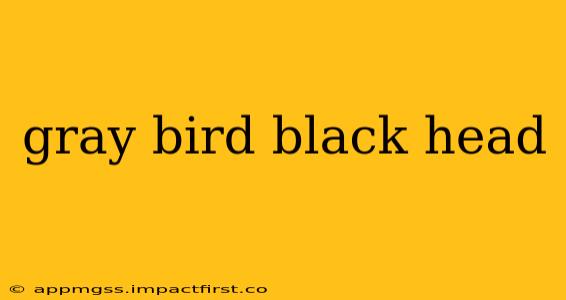Many bird species boast a captivating combination of gray and black plumage. This striking color scheme can make identification tricky, but with a little observation and knowledge, you can pinpoint the exact species gracing your backyard or local park. This guide will help you unravel the mystery behind gray birds with black heads, exploring various possibilities and providing key features to aid in identification.
What are some common gray birds with black heads?
Several bird species fit this description, and their geographic location plays a significant role in identification. Some common examples include:
-
Northern Mockingbird: Known for their exceptional mimicry abilities, these birds have a gray back and wings, a white belly, and a distinctive black cap that extends down to their eyes. They're found throughout the United States, Mexico, and parts of Central America.
-
Black-capped Chickadee: These tiny, energetic birds are easily recognized by their black cap, gray back, and white cheeks. Their small size and cheerful "chick-a-dee-dee-dee" call are additional distinguishing features. They inhabit North America, from Alaska to Mexico.
-
Gray Catbird: These birds have a slate-gray body, a black cap, and a long tail. They are characterized by their mewing song, which adds another layer to their identification. Gray Catbirds reside in eastern North America and parts of Canada.
-
Brown-headed Cowbird: Although the name suggests otherwise, the male Brown-headed Cowbird features a glossy black head, a brown back, and a lighter-colored breast. They are brood parasites, meaning they lay their eggs in the nests of other birds. Found across much of North America.
How can I tell the difference between a Northern Mockingbird and a Gray Catbird?
While both have a black cap and gray plumage, several subtle differences help distinguish them:
-
Size and Shape: Northern Mockingbirds are larger and more slender than Gray Catbirds. Their tails appear longer in proportion to their body.
-
Coloration: The gray of the Mockingbird is often slightly lighter than the slate gray of the Catbird.
-
Behavior: Mockingbirds are known for their acrobatic displays and mimicry, while Catbirds are more secretive and their behavior is generally less noticeable.
-
Song: Their songs are drastically different. The Mockingbird’s is complex and imitative, while the Catbird’s is a series of mewing and chattering calls.
What other identifying features should I look for?
Beyond the head and body color, several other features can aid in bird identification:
-
Size and Shape: Take note of the overall size of the bird, comparing it to other familiar birds in your area. Consider the length of its tail, beak, and wings.
-
Bill Shape: The shape and size of the beak can provide important clues about the bird's diet.
-
Leg and Foot Structure: The arrangement of toes and the length of the legs can also point to specific species.
-
Habitat: Where did you observe the bird? Different species prefer different habitats, so knowing the location can help narrow down the possibilities.
-
Behavior: Was the bird foraging on the ground, in trees, or in shrubs? How did it move?
What about birds with similar coloration but in different regions?
Remember that bird species vary across geographical regions. A bird with a black head and gray body observed in California might be different from one seen in Maine. Using regional field guides specific to your location will improve your identification accuracy considerably. Consulting online resources and birding communities can also assist in pinpointing a species based on your description and location.
Are there any resources to help me identify gray birds with black heads?
Yes! Several excellent resources are available:
-
Field Guides: Purchase a reputable bird field guide specific to your region. These books often include detailed descriptions, illustrations, and range maps.
-
Online Databases: Websites like All About Birds (allaboutbirds.org) and eBird (ebird.org) offer extensive databases with photos, descriptions, and range maps for various bird species.
-
Birding Apps: Mobile apps such as Merlin Bird ID and iNaturalist make bird identification easy and convenient through image recognition and other features.
By carefully observing and noting these features, you can confidently identify that mysterious gray bird with a black head fluttering in your view. Happy birding!
